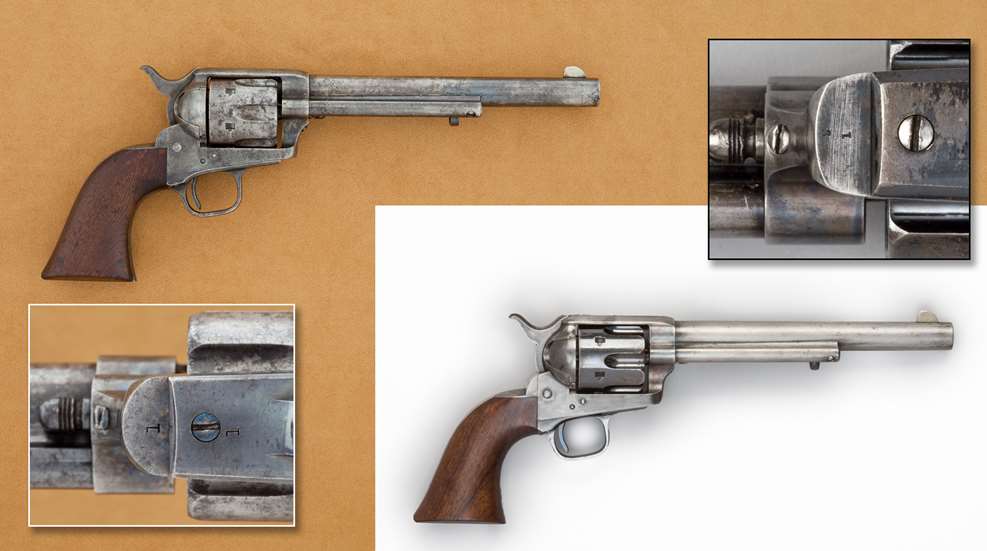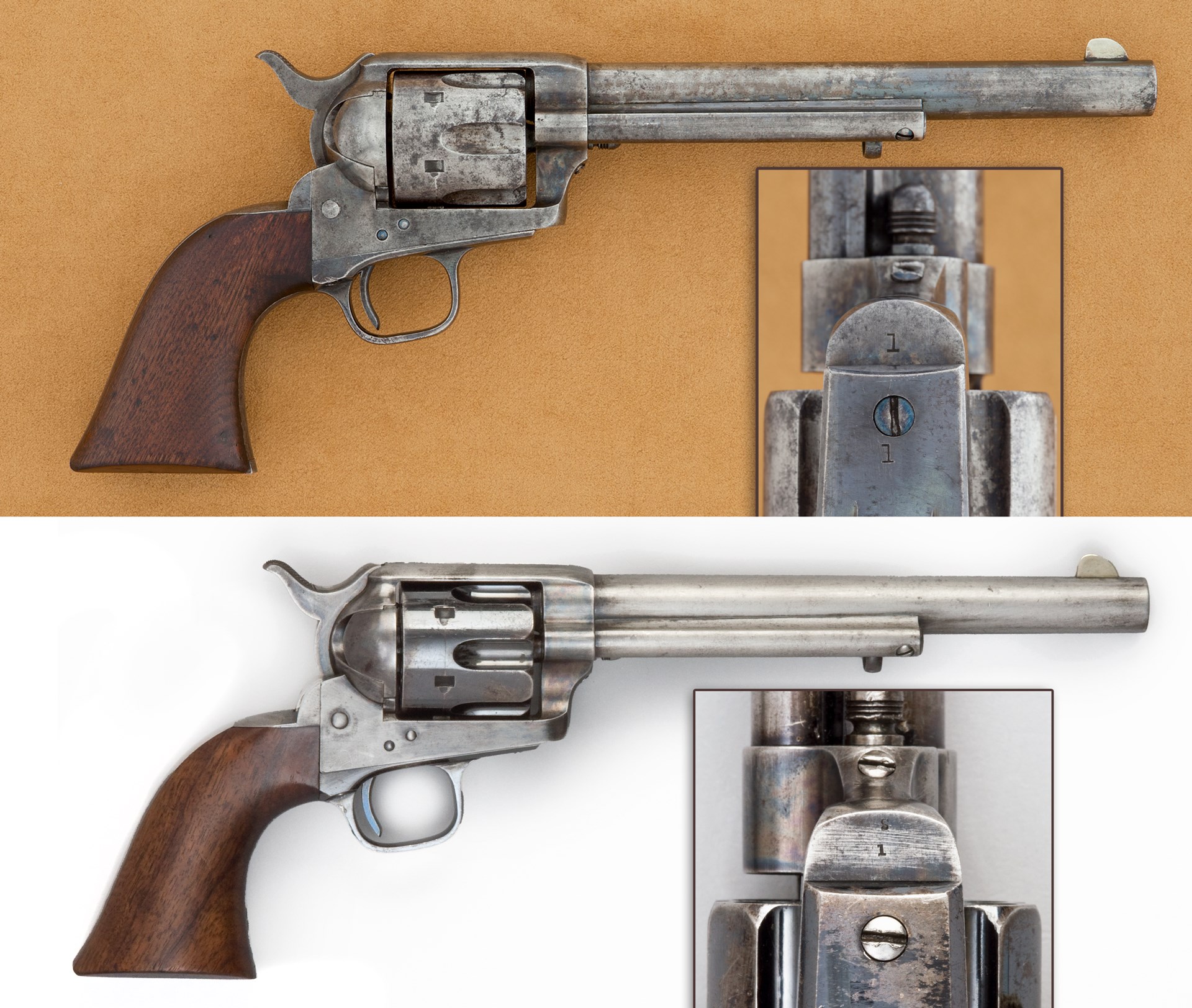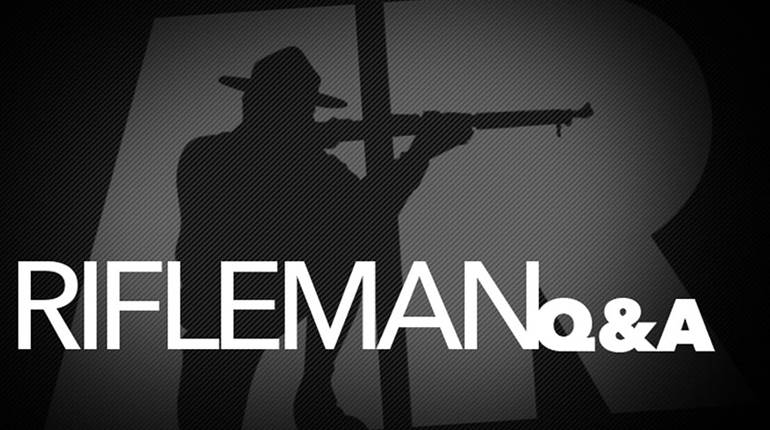
Q: I thoroughly enjoyed Rick Hacker’s recent article on the Colt SAA and its 150-year history, but I am confused by the fact that the photos of Serial No. 1 on the cover of American Rifleman differ from those found in some other articles and websites. Can you please clarify this matter?
A: Yours is one of many queries received about Colt SAA No. 1 since the publication of my article, “150 Years Of The Colt Single Action Army.” The short answer is that there are two different Single Action Army revolvers that were stamped with a “1” by the factory.
Obviously, a more detailed response is in order, but the answer is exacerbated by much misinformation on the Internet. The fact is, there were three different pre-production versions of the gun that would eventually become the first production SAA Serial No. 1 depicted on our January cover. And one of those pre-production guns was also stamped with a “1.”
The confusion regarding the multiple No. 1 designations began soon after the government field trials of 1872, when Colt created a prototype for what would eventually become the Single Action Army. Being a one-of-a-kind “new model,” this prototype was left in the white and stamped on its frame, “NM1872” under the number 44, to denote its original .44 S&W American chambering (later changed to .45 Colt and then back again). Long disregarded by factory employees, someone finally realized its importance. It now resides in a private collection and is depicted in C. Kenneth Moore’s Colt Single Action Army Revolver Study: New Discoveries available through Mowbray Publishing (gunandswordcollector.com).
 Colt’s Serial No. 1 Single Action Army, as shown on the cover of the January 2023 issue of American Rifleman (top), was its first production example of the revolver and therefore shows a great deal of use. SAA Serial No. “s 1” (bottom) is currently on display at The Autry Museum of the American West. It was a casehardened and blued sample meant to impress potential purchasers and still retains some of its original finish—even though a previous owner had, for some unknown reason, polished the barrel. Interestingly, the backstrap has been factory-cut for a shoulder stock. A close-up (inset, bottom) of “s 1” shows a block-letter-style serial number underneath what, at first glance, appears as a flaw in the metal but is actually the letter “s” for “sample,” as this was the first completely finished sample SAA produced by the factory. Note that the trigger guard flat is not stamped. By comparison, the first factory-produced SAA has a completely different style of numeral “1” stamped on both the frame and the trigger guard (inset, top), as were the rest of this legendary gun’s production.
Colt’s Serial No. 1 Single Action Army, as shown on the cover of the January 2023 issue of American Rifleman (top), was its first production example of the revolver and therefore shows a great deal of use. SAA Serial No. “s 1” (bottom) is currently on display at The Autry Museum of the American West. It was a casehardened and blued sample meant to impress potential purchasers and still retains some of its original finish—even though a previous owner had, for some unknown reason, polished the barrel. Interestingly, the backstrap has been factory-cut for a shoulder stock. A close-up (inset, bottom) of “s 1” shows a block-letter-style serial number underneath what, at first glance, appears as a flaw in the metal but is actually the letter “s” for “sample,” as this was the first completely finished sample SAA produced by the factory. Note that the trigger guard flat is not stamped. By comparison, the first factory-produced SAA has a completely different style of numeral “1” stamped on both the frame and the trigger guard (inset, top), as were the rest of this legendary gun’s production.
The NM1872 led to Colt’s creation of two blued and casehardened “sample” guns, appropriately serial-numbered “s 1” and “s 2,” both chambered in .44 S&W American. In 1872, Colt’s vice president and general agent, William Buel Franklin, took SAA “s 1” to Colt’s London agent, Prussia’s Baron Friedrich von Oppen (who was also the late Col. Colt’s brother-in-law), to garner European sales for the Single Action Army. This gun is described in detail in Moore’s book, Colt Single Action Army Revolvers and the London Agency (Mowbray Publishing). After extensive testing, in 1875 “s 1” was returned to Colt, where it subsequently disappeared. It re-appeared in 1967 as part of R.Q. Sutherland’s collection and then in books by his co-author, Colt consultant R.L. Wilson. By the early 1980s, the gun was in the Tennessee collection of Harry Durand. From there, with Wilson’s orchestration, it eventually was acquired by George A. Strichman, who, as CEO of Colt Industries, had an impressive collection of Colts, with a penchant for guns bearing Serial No. 1.
In 1990, a year after Strichman’s death, his collection was sold to The Autry Museum (now The Autry Museum of the American West), and included SAA “s 1”—where it is currently on display at the museum’s George Gamble Firearms Gallery. This is the sample gun often confused with the first production SAA that was shown on our January cover. If one compares the two serial numbers, however, the serifs and stylings are different. In addition, what appears to be a flaw in the metal above the number “1” on the Autry gun is actually a stamped letter “s” for “sample.” And even though some previous owner polished the barrel, the overall condition of “s 1” is superior to that of SAA No. 1, a gun that had obviously seen hard use.
As for Single Action Army “s 2,” it was submitted to the Army for testing. Afterward, given the rigors of those trials, which involved blackpowder fouling, rusting and pitting, it was most likely scrapped.
Now you know the rest of the story.
The author would like to extend a special thanks to: Josh Garrett-Davis, curator, The Autry Museum of the American West; James Nottage, author/past chief curator of The Autry Museum; Patrick J. Smith, curator, Museum of Connecticut History; and Colt authority/author John Kopec.





































